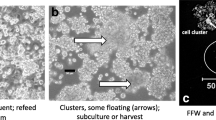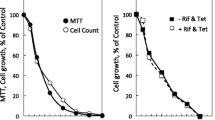Abstract
Wolbachia pipientis (Rickettsiales; Anaplasmataceae) is an obligate intracellular alpha proteobacterium that occurs in arthropods and filarial worms. Some strains of Wolbachia can be maintained as persistent infections in insect cell lines. C/wStr1 cells from the mosquito Aedes albopictus maintain a robust infection with Wolbachia strain wStr, originally isolated from the planthopper, Laodelphax striatellus. To explore possible functions of penicillin-binding proteins expressed from the wStr genome, C/wStr1 cells were exposed to ampicillin. Absolute levels of Wolbachia increased 3.5-fold in ampicillin-treated cells and fivefold in naive cells newly infected with wStr. Because cell numbers were depressed by ampicillin treatment, Wolbachia yield on a per-cell basis increased by 15-fold. The absence of a similar effect on wAlbB in Aa23 host cells suggests that the Wolbachia strain, the presence/absence of genes encoding penicillin-binding proteins, or the interaction between wAlbB and its host cells may modulate the effects of ampicillin.




Similar content being viewed by others
References
Altincicek B, Kollas AK, Eberl M, Wiesner J, Sanderbrand S, Hintz M, Beck E, Jomaa H (2001) LytB, a novel gene of the 2-C-methyl-D-erythritol 4-phoshate pathway of isoprenoid biosynthesis in Escherichia coli. FEBS Lett 499:37–40
Baldridge GD, Baldridge AS, Higgins LA, Witthuhn BA, Markowski TW, Fallon AM (2014) Proteomic profiling of a robust Wolbachia infection in an Aedes albopictus mosquito cell line. Mol Microbiol 94:537–556. https://doi.org/10.1111/mmi.12768.
Beckmann JF, Ronau JA, Hochstrasser M (2017) A Wolbachia deubiquitylating enzyme induces cytoplasmic incompatibility. Nature Microbiol 2:17007. https://doi.org/10.1038/nmicrobiol.2017.7
Bonneau M, Atyame C, Beji M, Justy F, Cohen-Gonsaud M, Sicard M, Weill M (2018) Culex pipiens crossing type diversity is governed by an amplified and polymorphic operon of Wolbachia. Nat Commun 9:319. https://doi.org/10.1038/s41467-017-02749-w
Boucher Y, Doolittle WF (2000) The role of lateral gene transfer in the evolution of isoprenoid biosynthesis pathways. Mol Microbiol 37:703–716
Carfi A, Pares S, Duee E, Galleni M, Duez C, Frere JM, Dideberg O (1995) The 3-D structure of a zinc metallo-β-lactamase from Bacillus cereus reveals a new type of protein fold. EMBO J 14:4914–4921
Daiyasu H, Osaka K, Ishino Y, Toh H (2001) Expansion of the zinc metallo-hydrolase family of the beta-lactamase fold. FEBS Lett 503:1–6
Fallon AM (2008) Cytological properties of an Aedes albopictus mosquito cell line infected with Wolbachia strain wAlbB. In Vitro Cell Dev Biol - Animal 44:154–161
Fallon AM (2014) Flow cytometric evaluation of the intracellular bacterium, Wolbachia pipientis, in mosquito cells. J Microbiol Methods 107:119–125
Fallon AM, Baldridge GD, Higgins LA, Witthuhn BA (2013) Wolbachia from the planthopper Laodelphax striatellus establishes a robust, persistent, streptomycin-resistant infection in clonal mosquito cells. In Vitro Cell Dev Biol - Animal 49:66–73
Fallon AM, Kurtti TJ (2005) Cultured cells as a tool for analysis of gene expression. In Marquardt WC (ed) The biology of disease vectors Vol. 2. Elsevier, New York, 2005. Chapter 35, pp. 539–549
Gustafson CE, Kaul S, Ishiguro EE (1993) Identification of the Escherichia coli lytB gene, which is involved in penicillin tolerance and control of the stringent response. J Bacteriol 175:1203–1205
Ishino F, Matsuhashi M (1981) Peptidoglycan synthetic enzyme activities of highly purified penicillin-binding protein 3 in Escherichia coli: a septum-forming reaction sequence. Biochem Biophys Res Commun 101:905–911
Lange BM, Rujan T, Martin W, Croteau R (2000) Isoprenoid biosynthesis: the evolution of two ancient and disstinct pathways across genomes. Proc Natl Acad Sci U S A 97:13172–13177
McAteer S, Couldon A, McLennan N, Masters M (2001) The lytB gene of Escherichia coli is essential and specifies a product needed for isoprenoid synthesis. J Bacteriol 183:7403–7407. https://doi.org/10.1128/JB.183.24.7403-7407.2001
Noda H, Miyoshi T, Koizumi Y (2002) In vitro cultivation of Wolbachia in insect and mammalian cell lines. In Vitro Cell Dev Biol-Animal 38:423–427
O’Neill SL, Pettigrew M, Sinkins SP, Braig HR, Andreadis TG, Tesh RB (1997) In vitro cultivation of Wolbachia pipientis in an Aedes albopictus cell line. Insect Mol Biol 6:33–39
Palzkill T (2013) Metallo-β-lactamase structure and function. Ann N Y Acad Sci 1277:91–104. https://doi.org/10.1111/j.1749-6632.2012.06796.x
Rohmer M (1999) The discovery of a mevalonate-independent pathway for isoprenoid biosynthesis in bacteria, algae and higher plants. Nat Prod Rep 16:565–574
Sauvage E, Derouaux A, Fraipont C, Joris M, Herman R, Rocaboy M et al (2014) Crystal structure of penicillin-binding protein 3 (PBP3) from Escherichia coli. PLoS One 9(5):e98042. https://doi.org/10.1371/journal.pone.0098042
Shih KM, Gerenday A, Fallon AM (1998) Culture of mosquito cells in Eagle’s medium. In Vitro Cell Develop Biol – Animal 34:629–630
Taschner PEM, Huls PG, Pas E, Woldringh CL (1988) Division behavior and shape changes in isogenic ftsZ, ftsQ, ftsA, pbpB, and ftsE cell division mutants of Escherichia coli during temperature shift experiments. J Bacteriol 170:1533–1540
Van Bambeke F, Michot J-M, Tulkens PM (2003) Antibiotic efflux pumps in eukaryotic cells: occurrence and impact on antibiotic cellular pharmacokinetics, pharmacodynamics and toxicodynamics. J Antimicrob Chemother 51:1067–1077
Wang L, Khattar MK, Donachie WD, Lutkenhaus J (1998) FtsI and FtsW are localized to the septum in Escherichia coli. J Bacteriol 180:2810–2816
Wu M, Sun LV, Vamathevan J, Riegler M, Deboy R, Brownlie JC, McGraw EA, Martin W, Esser C, Ahmadinejad N, Wiegand C, Madupu R, Beanan MJ, Brinkac LM, Daugherty SC, Durkin AS, Kolonay JF, Nelson WC, Mohamoud Y, Lee P, Beerry K, Young MB, Utterback T, Weidman J, Nierman WC, Paulsen IT, Nelson KE, Tettelin H, O’Neill SL, Eisen J (2004) Phylogenomics of the reproductive parasite Wolbachia pipientis wMel: a streamlined genome overrun by mobile genetic elements. PLoS Biol 2:0327–0341
Funding
This work was supported by NIH grant AI081322 and by the University of Minnesota Agricultural Experiment Station, St. Paul, MN.
Author information
Authors and Affiliations
Corresponding author
Rights and permissions
About this article
Cite this article
Fallon, A.M. Strain-specific response to ampicillin in Wolbachia-infected mosquito cell lines. In Vitro Cell.Dev.Biol.-Animal 54, 580–588 (2018). https://doi.org/10.1007/s11626-018-0279-x
Received:
Accepted:
Published:
Issue Date:
DOI: https://doi.org/10.1007/s11626-018-0279-x




